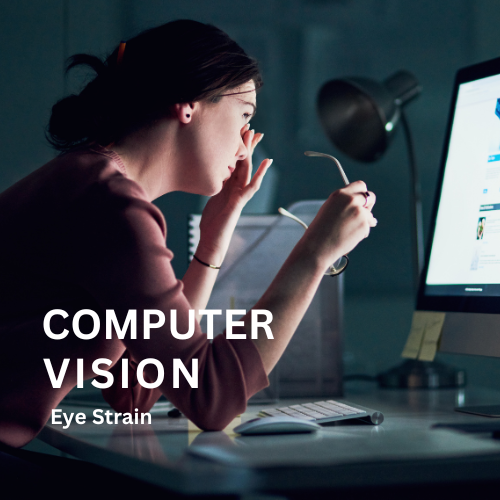Digital Eye Strain


Before the digital era, people primarily encountered eye strain from activities such as reading, studying, or doing close work for extended periods. However, the advent of digital screens has introduced new challenges due to their unique characteristics, such as the emission of blue light and the need for prolonged near-focused visual attention.
The term “computer vision syndrome” was coined in the 1990s to describe the eye and vision problems associated with computer use. As technology advanced and the use of digital screens became even more pervasive, the term “digital eye strain” emerged to encompass a broader range of devices and screen-related issues.
Digital eye strain, also known as computer vision syndrome, is a condition that refers to a group of eye and vision-related problems that can occur due to prolonged use of digital screens. This includes computers, smartphones, tablets, e-readers, and other electronic devices with visual displays.
The primary cause of digital eye strain is the extended periods of time spent looking at digital screens, which can lead to various symptoms and discomfort. Some common symptoms of digital eye strain include:
- Eyestrain: General discomfort, tiredness, or soreness in the eyes.
- Dry eyes: Insufficient blinking while staring at screens can lead to dryness and irritation.
- Blurry vision: Difficulty in focusing or experiencing temporary blurred vision.
- Headaches: Persistent or occasional headaches, often accompanied by eye discomfort.
- Neck and shoulder pain: Poor posture or maintaining the same position for long periods can cause muscle strain.
- Difficulty focusing: Eyes may have trouble adjusting focus between the screen and other objects.
Several factors contribute to digital eye strain. The most significant ones are:
- Blue light exposure: Digital screens emit blue light, which can contribute to eye fatigue and disrupt sleep patterns.
- Screen glare and reflections: Poor lighting conditions or screen glare can strain the eyes.
- Viewing distance and angle: Holding devices too close or at an awkward angle can cause additional strain.
- Reduced blinking: Staring at screens often leads to decreased blink rate, causing dryness and irritation.
To reduce digital eye strain, consider the following tips:
- Take regular breaks: Follow the 20-20-20 rule—every 20 minutes, look away from the screen and focus on an object 20 feet away for at least 20 seconds.
- Adjust screen settings: Optimize screen brightness, contrast, and font size to reduce strain.
- Maintain proper posture: Sit at an ergonomic distance and angle, with the screen slightly below eye level.
- Minimize glare: Use anti-glare screens or adjust lighting to minimize reflections.
- Blink more frequently: Be conscious of blinking to keep the eyes lubricated.
- Use artificial tears: Lubricating eye drops can help alleviate dryness.
- Limit screen time: Take regular breaks and try to reduce overall screen usage when possible.
If symptoms persist or worsen, it is advisable to come in for an examination and further evaluation and guidance.
Gregory Scimeca, M.D.
Ophthalmologist and Medical Director
The Eye Professionals
Our Locations
